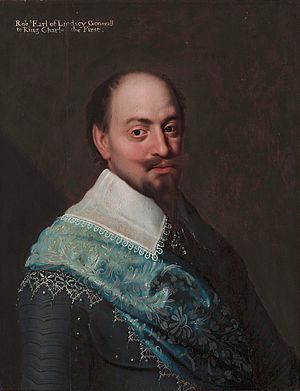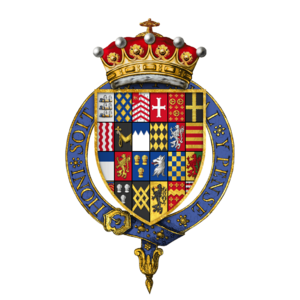Robert Bertie, 1st Earl of Lindsey facts for kids
Quick facts for kids
Robert Bertie
|
|
|---|---|
| Earl of Lindsey | |

Portrait by Michiel Jansz. van Mierevelt
|
|
| Born | 16 December 1582 |
| Died | 24 October 1642 (aged 59) Warwick Castle, Warwickshire, England |
| Buried | Edenham, Lincolnshire |
| Noble family | Bertie |
| Spouse(s) | Elizabeth Montagu |
| Issue …among others |
Montagu Bertie, 2nd Earl of Lindsey |
| Father | Peregrine Bertie, 13th Baron Willoughby de Eresby |
| Mother | Mary de Vere |
Robert Bertie, 1st Earl of Lindsey (born December 16, 1582 – died October 24, 1642) was an important English nobleman, soldier, and advisor to the King. He was known as the 14th Baron Willoughby de Eresby from 1601 to 1626, before becoming the 1st Earl of Lindsey. He played a key role in the early days of the English Civil War.
Contents
Robert Bertie's Early Life and Family
Robert Bertie was the son of Peregrine Bertie, 13th Baron Willoughby de Eresby and Mary de Vere. His mother was the daughter of John de Vere, 16th Earl of Oxford. Robert had a very special start to life.
Queen Elizabeth I was his godmother. Two of her favorite noblemen, Robert Dudley, 1st Earl of Leicester and Robert Devereux, 2nd Earl of Essex, were his godfathers. He was even named Robert after them.
Robert Bertie's Military Training
Robert Bertie gained a lot of military experience from a young age. He joined the Earl of Essex's trip to Cádiz, a city in Spain. After that, he served in the Netherlands, fighting under a famous leader named Maurice of Nassau, Prince of Orange.
He even took temporary command of English forces during the Siege of Rheinberg in 1601. During the peaceful time of King James I's rule, many young English noblemen went to fight in wars in Europe. They saw these campaigns as a way to finish their education and become well-rounded gentlemen.
How Robert Bertie Became Earl of Lindsey
In 1601, Robert Bertie became the Baron Willoughby de Eresby after his father passed away. Later, on November 22, 1626, he was given the new title of Earl of Lindsey. He chose this name from the northern part of Lincolnshire, which was once an old kingdom called Lindsey.
Robert Bertie as a Land Developer
Robert Bertie was also involved in a big project to drain land in a marshy area called The Fens. This area was located between the River Glen and The Haven near Boston, Lincolnshire. The drained area was named the Lindsey Level after him.
He was the main person behind this drainage work. The project was finished in 1638. However, when the English Civil War began, the project was not looked after, and the land became marshy again. More than a hundred years later, it was drained once more and called the Black Sluice Level.
Robert Bertie and the English Civil War
As tensions grew between King Charles I and Parliament, Lord Lindsey worried that war was coming. He began to train his tenants, who were people living on his land, in Lincolnshire and Northamptonshire. He formed them into a group of foot soldiers, called an infantry regiment.
The First Siege of Hull
In April 1642, Lord Lindsey went with the King to Hull. They wanted to get control of the city's weapons and supplies for the King's army. However, the governor, Sir John Hotham, 1st Baronet, who supported Parliament, refused. He made the King and his group leave.
In July, the King returned with a larger army to try and take Hull by force. Lord Lindsey was put in charge of the siege. But the Parliamentarian troops inside the city, led by Sir John Meldrum, fought back well. On July 27, they blew up the King's army's weapon storage. After losing their supplies, Lord Lindsey's forces had to give up and retreat.
The Battle of Edgehill
Because Lord Lindsey was a very experienced soldier, King Charles I chose him to be the General-in-chief of the Royalist army. This was for the first major battle of the English Civil War, the Battle of Edgehill. Lord Lindsey was 59 years old at this time.
However, the King made a decision that caused problems. He said that the cavalry (horse soldiers), led by his nephew Prince Rupert of the Rhine, would only take orders from the King himself. Prince Rupert was only 22 and, though he had fought in other wars, he hadn't learned that cavalry should also help the foot soldiers.
Lord Lindsey's son, Montagu Bertie, Lord Willoughby, was also with him. Montagu had fought against the Spanish in the Netherlands. He was a captain in the King's special guards. Famous artist Anthony van Dyck painted portraits of both father and son. Lord Lindsey looked like a precise, old warrior in his armor. Montagu looked like a typical "cavalier," tall and graceful.
On the morning of October 23, 1642, King Charles saw the Parliamentarian army gathering. He decided to fight them. It took a long time for his own army to get ready, as many of the officers were gentlemen who found it hard to organize their farmers and servants into soldiers.
Battle Plans and Disagreements
Lord Lindsey knew the Parliamentarian commander, Robert Devereux, 3rd Earl of Essex, very well. They had studied battle tactics together in Holland. Lindsey respected Essex's skills and believed the Royal army needed to be very careful.
But Prince Rupert had seen quick, powerful cavalry charges in other wars. He thought a sudden charge by the Royal horsemen would easily defeat the Parliamentarians. The King was unsure what to do. He was sad about fighting his own people and had never seen a battle. He eventually agreed to Rupert's plan, which meant the troops would be arranged in a "Swedish" style.
This decision was a big insult to Lord Lindsey, the General-in-chief. But it did not stop his loyalty. He quietly gave up his title as General, knowing it would only cause confusion. He then rode to lead his own Lincolnshire regiment of foot soldiers. He felt sorry for the King's difficult situation and was determined to do his duty. His regiment stood directly opposite the Parliamentarian leader's standard.
The Battle Unfolds
In the afternoon, the Royal forces moved down the hill. Prince Rupert's cavalry charge was very successful. The Parliamentarian horsemen quickly ran away, with the Royalists chasing them. However, the main part of the Royal army, the foot soldiers, held their ground.
For a while, the battle was very close. Then, a large group of Parliamentarian cavalry, who had been waiting, attacked the Royal forces. This happened just as the Royalists were running out of ammunition. The Royalists bravely retreated step by step. Rupert returned from his chase, but he could not gather his scattered horsemen. Many were busy looting or still chasing the enemy.
Lord Lindsey's Death
During the battle, Lord Lindsey was shot in the thigh bone and fell. Parliamentarian cavalry quickly surrounded him. But his son, Lord Willoughby, saw the danger. He bravely rode alone into the enemy, reached his father, and held him in his arms. He didn't worry about his own safety.
The Parliamentarian soldiers told him to surrender. Lord Willoughby quickly gave up his sword and carried his father to a nearby shed. He laid him on some straw and tried to stop the bleeding, while a Parliamentarian guard watched.
It was a very cold night. Lord Lindsey whispered, "If it pleases God I should survive, I never will fight in the same field with boys again!" He likely blamed young Rupert for the problems. His thoughts were on the war, while his son's thoughts were only on him. It was impossible to stop the bleeding, and the old man slowly lost his strength.
Around midnight, Lord Lindsey's old friend Essex, the Parliamentarian commander, heard about his condition. He sent officers to check on him and promised that surgeons would arrive soon. Lord Lindsey was still very strong in spirit. He spoke to the officers about their broken promises and the wrongness of rebellion. They felt uncomfortable and left the hut one by one. They even convinced Essex not to visit his old friend himself.
The surgeon arrived, but it was too late. Lord Lindsey was too weak from the cold and blood loss. He died early in the morning on October 24, 1642. He was being carried through the gates of Warwick Castle, where other Royalist prisoners were kept. His son, Lord Willoughby, remained a prisoner for about a year, even though King Charles tried hard to get him released. Lord Lindsey is buried in St Michael and All Angels Church in Edenham, Lincolnshire.
It's important not to confuse Lord Lindsey with Ludovic Lindsay, 16th Earl of Crawford, who also fought for the King at the Battle of Edgehill.
Robert Bertie's Marriage and Children
In 1605, Lord Lindsey married Elizabeth Montagu. She was the sister of Edward Montagu, 1st Baron Montagu of Boughton. Robert and Elizabeth had thirteen children together:
- Montagu Bertie, 2nd Earl of Lindsey (1608–1666)
- Hon. Sir Roger Bertie (died October 15, 1654), who married Ursula Lawley.
- Hon. Robert Bertie (January 1, 1619 – 1708), who married three times.
- Hon. Sir Peregrine Bertie, who married Anne Hardeby.
- Capt. Hon. Francis Bertie (died 1641), who was killed in Ireland.
- Capt. Hon. Henry Bertie (died 1643), who was killed at the First Battle of Newbury.
- Hon. Vere Bertie, who never married.
- Hon. Edward Bertie (October 17, 1624 – December 25, 1686).
- Lady Katherine Bertie, who married Sir William Paston, 1st Baronet around 1631. They had one son, Robert Paston, 1st Earl of Yarmouth.
- Lady Elizabeth Bertie (died February 28, 1684), who married Sir Miles Stapleton in 1661.
- Lady Anne Bertie (died 1660), who never married.
- Lady Mary Bertie, who married Rev. John Hewett and later Sir Abraham Shipman.
- Lady Sophia Bertie, who married Sir Richard Chaworth.
The important role of Lord Great Chamberlain was passed down to Robert Bertie after his cousin, Henry de Vere, 18th Earl of Oxford, died. Robert was the closest male relative.



